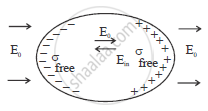Advertisements
Advertisements
Questions
Distinguish with the help of a suitable diagram, the difference in the behaviour of a conductor and a dielectric placed in an external electric field.
Explain, using suitable diagrams, the difference in the behaviour of a conductor and dielectric in the presence of external electric field
Solution
When a conductor is placed in an external electric field, the free charge carriers move and charge distribution in the conductor adjusts itself in such a way that the electric field caused by induced charges opposes the external field within the conductor. This happens until, in the static situation, the two fields cancel each other and the net electrostatic field in the conductor is zero.

In contrast to conductors, dielectrics are non-conducting substances i.e., they have no (or negligible number of ) charge carriers. Thus, in a dielectric, free movement of charges is not possible. It turns out that the external field induces dipole moment by stretching or reorienting molecules of the dielectric. The collective effect of all the molecular dipole moments is the net charge on the surface of the dielectric which produce a field that opposes the external field, unlike a conductor in an external electric field. However, the opposing field so induced does not exactly cancel the external field. It only reduces it. The extent of the effect depends on the nature of the dielectric.
APPEARS IN
RELATED QUESTIONS
Electric intensity due to a charged sphere at a point outside the sphere decreases with...................
Define the terms polarization of a dielectric and write its relation with susceptibility.
Which of the following waves can be polarized (i) Heat waves (ii) Sound waves? Give reason to support your answer.
Two metal plates having charges Q, −Q face each other at some separation and are dipped into an oil tank. If the oil is pumped out, the electric field between the plates will
A dielectric slab is inserted between the plates of a capacitor. The charge on the capacitor is Q and the magnitude of the induced charge on each surface of the dielectric is Q'.
Explain briefly, using a proper diagram, the difference in behaviour of a conductor and a dielectric in the presence of external electric field.

Define the term polarization of a dielectric and write the expression for a linear isotropic dielectric in terms of electric field.
Explain briefly, using a proper diagram, the difference in the behavior of a conductor and a dielectric in the presence of an external electric field.
An isolated parallel plate capacitor is maintained at a certain potential difference. When a 3 mm thick slab is introduced between the plates, in order to maintain the same potential difference the distance between the plates is increased by 2.4 mm. The dielectric constant of the slab will be ______.
